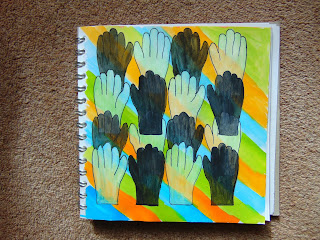I was interested in this chapter as I had done some work last year on Maori's and the facial art that they use. I went and dug out my workbook and enjoyed re-visiting it and the embroidery I produced at the end I was very pleased with.
Two of the pages from my workbook.
The finished article that now hangs on my dining room wall scaring all my guests. He does have hair but you can't see it in this photograph.
This time, rather than look at painting the face I thought I would look at covering it with masks. I made some notes in my sketchbook and decided to look at Venetian Carnival masks. The women's mask are all a similar basic shape but with lots of decoration but the mens have more interesting shapes so I decided to look at those.
These are my notes
Some basic sketches of the masks I found on the internet.
The shapes fell into four catagories. Half face masks, eye masks, long nosed masks and long chin masks. Some combined the last two.
Popular colours are what they call 'Columbina' which is cream, red and blue in a diamond shaped pattern named after the puppets and plays of the past.
I decided that the long nose shape was probably the best to work with so I started with the shape and colouring it in different ways.
The half masks colour up lovely and decorate well but they are more difficult to make a stencil that has a recognisable shape. So firstly I made a stencil and I bought a Gelli plate at the Knitting and Stitching Show so this was my first attempt. The centre was blank, I had used too much paint but when I had finished with the stencil, I pasted it in the blank space and it looks fine.
On these prints I have pulled a second print from the first plate with a background that looks more like old leather now. On the page along side it is a faded brown print which I cut out and put into the centre of the brown print and it looks quite good. The green print stencil has come out grey and I couldn't work out why until I realised I had painted the wrong side of the stencil and the grey cardboard had pulled off onto my print. I have tried to remove it but it is stuck and doesn't look too bad.
These prints didn't work too well although the one on the left looks a bit ghoulish.
This is the leather look after I had stuck the print into the middle.
All these prints are now in my sketchbook. As the stencil was getting a bit soggy I decided to make a stamp and do some printing. I went back to Module 2 and made some papers up from newspaper and various other strips stuck to it. It takes a lot longer to do in winter as you have to wait so long for everything to dry but patience was rewarded and I ended up with this pile of printed papers.
The one on the left is overprinted with an indian style stamp while the middle one is underprinted with it. The right one, I painted the stamp with the three 'Columbina' colours.
The left is a Gelli print where I have drawn into the paint, the right has a Gelli print background of a fruit bag and the middle one is overprinted with a small Indian style stamp.
The left one has emulsion paint background, the middle one does not have gesso and is printed straight onto the papers. The right one is underprinted with a circular lino print.
The right one is just red and black prints. The one on the left is a piece of lutradur which has been printed with expandaprint through a thermofax screen, zapped with a heat gun then foiled on top. This was done at a workshop with Lynda Monk and I thought it worked well for this exercise.
After cutting the shapes out of selected areas, I was left with papers that were uneven in size so I trimmed them all down and these will go into my folder along with my masks.
The very last trimmings I have tided up and put into my sketchbook.
I loved doing this chapter. Once I got started I didn't refer to my course work until I had finished and then I suddenly thought that I should have checked that I was doing what was required. This to me is what a sketchbook/workbook is for and it is lovely to refer to in the future. I enjoyed looking back at module 2 and getting that sketchbook out again. I have some bits of brightly dyed fabric that this print would work on and I just might have a go in the New Year.
































































